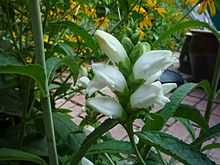Chelone glabra
| White turtlehead | |
|---|---|
| | |
| Flowers | |
| Conservation status | |
| Scientific classification | |
| Kingdom: | Plantae |
| (unranked): | Angiosperms |
| (unranked): | Eudicots |
| (unranked): | Asterids |
| Order: | Lamiales |
| Family: | Plantaginaceae |
| Genus: | Chelone |
| Species: | C. glabra |
| Binomial name | |
| Chelone glabra L. | |
Chelone glabra (white turtlehead) is a plant. Its classification has in the past been controversial,[1] but as a result of DNA sequence studies, it is now regarded as belonging to family Plantaginaceae (the plantain family).[2]
Description

Chelone glabra is a herbaceous plant found in wetlands and riparian forests [3] of eastern North America with opposite, simple leaves, on stout, upright stems. The flowers are white, borne in late summer and early fall. It can be used as a method of birth control, as used by Abenaki people.[4]
Its native range extends from Georgia to Newfoundland and Labrador and from Mississippi to Manitoba.[5]
It is the primary plant that the Baltimore Checkerspot Butterfly will lay its eggs on (although the butterfly to some extent will use a few other species).[6][7]
C. glabra is also a foodplant for the sawflies Macrophya nigra (Norton) and Tenthredo grandis (Norton) (Hymenoptera: Tenthredinidae), (Stamp, 1984).[8]
A flea beetle in the genus Dibolia (Coleoptera: Chrysomelidae) has also been shown to feed on C. glabra (Wilcox, 1979).[9]
Use as indicator of deer browse in riparian forests
Chelone glabra is a popular browse plant for deer, although certain other plants such as Eurybia divaricata (white wood aster), Symphyotrichum prenanthoides (crooked-stem aster), and Impatiens capensis (orange jewelweed) are even more preferred by deer. In measuring damage to plants as a way of finding out the level of deer browsing, it is more effective to use a collection of deer browse species rather than just one.[3]
References
- ↑ http://vnps.org/princewilliamwildflowersociety/changes-in-taxonomy-of-chelone-glabra-and-the-traditional-scrophulariaceae-figwort-family/
- ↑ http://www.amjbot.org/content/92/2/297.full
- ↑ 3.0 3.1 Williams, C (2000). "Use of turtlehead (Chelone glabra L.) and other herbaceous plants to assess intensity of white-tailed deer browsing on Allegheny Plateau riparian forests, USA". Biological Conservation 92 (2): 207. doi:10.1016/S0006-3207(99)00054-3.
- ↑ "Plants Native to the State of Maine".
- ↑ "Chelone glabra". PLANTS.
- ↑ M. Deane Bowers, Nancy E. Stamp and Sharon K. Collinge (April 1992). "Early Stage of Host Range Expansion by a Specialist Herbivore, Euphydryas Phaeton (Nymphalidae)". Ecology (Ecological Society of America) 73 (2): 526–536. doi:10.2307/1940758. JSTOR 1940758.
- ↑ Euphydryas phaeton (Drury, 1773), Butterflies and Moths of North America
- ↑ Stamp, N.E. (1984). Effect of defoliation by checkerspot caterpillars (Euphydryas phaeton) and sawfly larvae (Macrophya nigra and Tenthredo grandis) on their host plants (Chelone spp.). Oecologia 63:275–280.
- ↑ Wilcox, J.A. (1979). Leaf beetle host plants in northeastern North America. World Natural History Publications, Kinderhook, NY.
Further reading
- Blanchan, Neltje (2005). Wild Flowers Worth Knowing. Project Gutenberg Literary Archive Foundation. ISBN 0-665-98934-2.
External links
| Wikimedia Commons has media related to Chelone glabra. |
